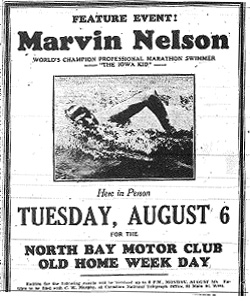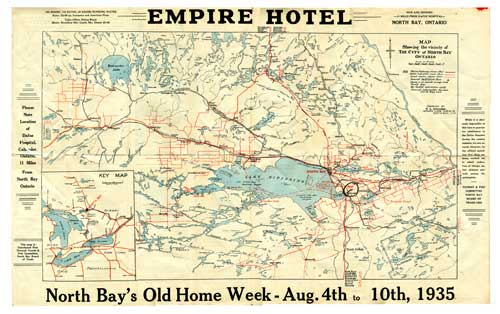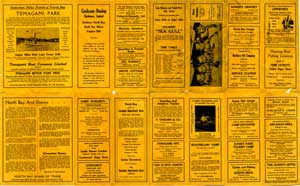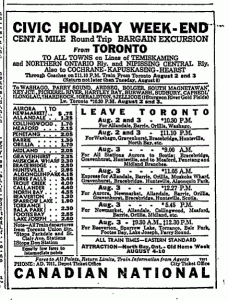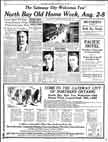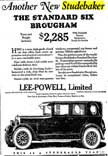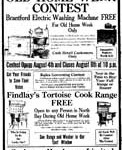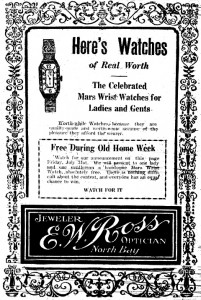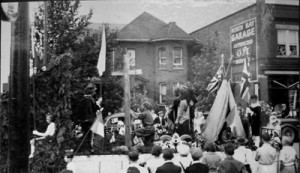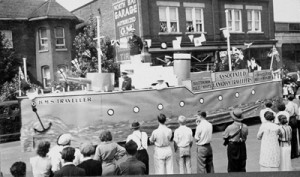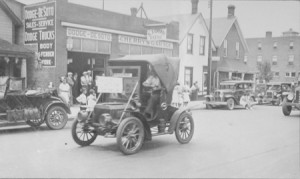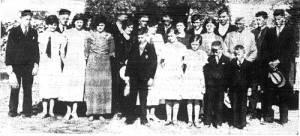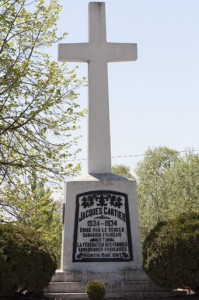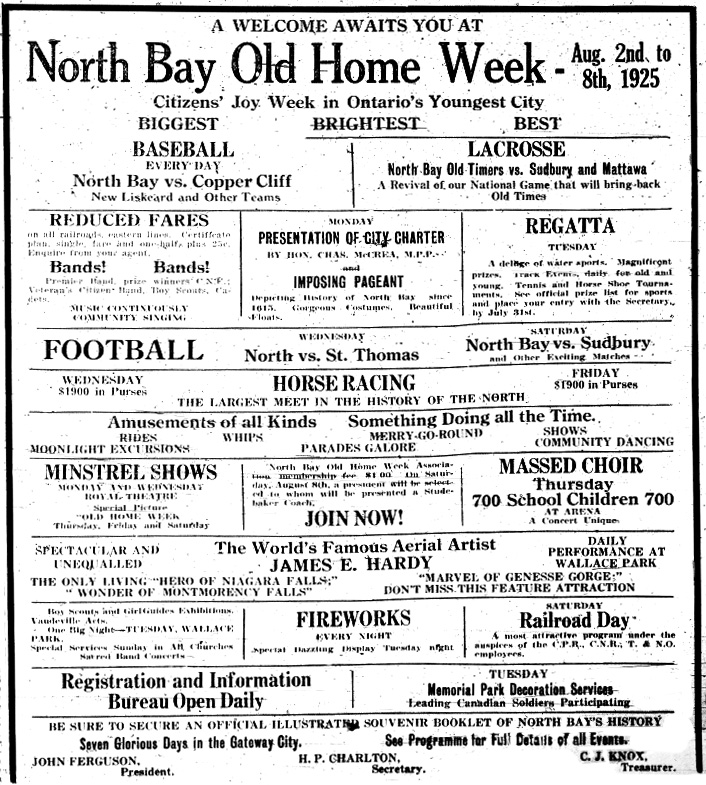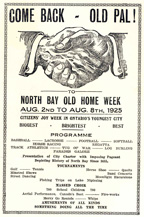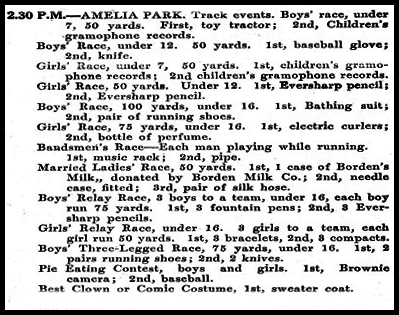“Impressive Tribute Paid Solider Dead,” The Nugget, August 5, 1935, p. 3, 5.
[Transcribed by F. Noël with permission.]
Impressive Tribute Paid Soldier Dead
Solemn Opening 159th Re-Union
Memorial Services at Cenotaph and Lee Park Sunday
BIG ASSEMBLIES
Their name liveth forever more.
Solemn, with a touch of sadness, yet inspiring for all its solemnity, was the drum- head memorial service at Lee Park Sunday afternoon, and the ceremony at Memorial Park in the morning.
The address of Rev. (Captain) N. Clark Wallace, main speaker, was heard by at least 2,000 persons at Lee Park. Standing before the pyramid of drums, Rev. Mr. Wallace told the gathering that the honor of the fallen cannot be sullied. It remains pure throughout eternity. “They are not on trial. We are on trial,” he said. His text was “Their name liveth forever more.”
Perhaps the most touching feature of the service was the placement of a wreath at the plaque of the unknown soldier. While the band softly played a funeral march the wreath was deposited on behalf of the 159th Battalion by Col. E. F. Armstrong, officer commanding. It was a tense moment for all, particularly the veterans, who were formed up in a square facing the drum-head.
Patriotism, Sacrifice
In his address, Rev. Mr. Wallace outlined the true meaning of the terms patriotism and self-sacrifice, stating men who went overseas set up real examples of these virtues.
“The real cause of the war,” he said, in reviewing the struggle’s beginning briefly, “was Germany’s desire to rule the world. We didn’t go to war to make the world safe for democracy, through that has become the popular belief. We entered the fight for liberty, freedom, truth, justice, and honor. The men who went to war believed those things worth fighting for.
“Today it almost seems as if the soldier is an outcast” Rev. Mr. Wallace continued. There has been so much preaching against armament, so much talk of pacifism and world peace forever, he contended, that the men who fought in the Great War had almost become outcasts.
“It is good to gather together to pay tribute to the fallen. Their honor, their sacrifice, must remain unsullied. Yet it is wrong to say their honor must remain unsullied. It can not be sullied for they fought the good fight, they kept the faith. Their name liveth forever more.”
Captain T. Ellwood of the Salvation Army pronounced the invocation following the doxology which opened the service. Two hymns followed, then a scripture reading by Rev. Garland Gladstone Lacey.
A short prayer by Rev. H.A. Sims followed the laying of the wreath. After Rev. Mr. Wallace’s address one minute of silence was observed in honor of the fallen. A trio of bugles sent the “Last Post” shrilling into the breeze. The benediction was pronounced by Rev. (Captain) P.C. Reed. The National Anthem closed the service.
Arrayed in their berets and badges, members of the 159th Battalion presented a colorful and smart appearance as they paraded to and from the park. The All Verterans Band was under the leadership of Frank Saunders.
The “Order of Service” was presented to the 159th Battalion Association by Mrs. John G. Ross, in remembrance of her brother, Lieut. W.K. Clarke, killed in the Great War March 7, 1918.
A plea for a continuation of the war to end war, on behalf of God and in the interests of world peace formed the theme of Capt. Rev. P.C. Reed’s address to the members of the 159th Battalion and other units at the Sunday morning memorial service in Memorial Park.
Classing the war against war as one from which there is no discharge save death, Capt. Reed pleaded with his hearers to strive as citizen-soldiers to leave behind them a mark of accomplishment towards this end, Canada’s citizen soldiery was classed as the bravest in the Allied forces during the World War, and that reputation must be upheld in the new war, Capt. Reed exhorted.
“It is a war without guns or bay-
cont on Page 5.
SOLEMN OPENING
(Continued from Page 3)
onets that we are fighting now,” Capt. Reed explained, “but a war which we must fight, not against God, as some said we were in the last war, but for God and against sin and selfishness. We cannot stand further losses from war, but we must continue in this great war for God.
“Captain Rev. Stanley Lambert, the padre of Christie Street Hospital, Toronto, said recently that every fifth day since the end of the war, a soldier has died in Christie Street Hospital. Like the Olympic, which was discharged recently after long years of service, and like the troop ships which received their discharge while on service, all of those vessels a lot of you boys will know, the old soldiers are getting their discharge,” Capt. Reed explained.
“From this new war against war and sin, however, there can be no discharge, a vote which the men who profit from warfare are trying to discourage. You who know the hell and horrors of war should be leaders in this great battle which all citizen-soldiers are fighting today.
“I am reminded today of a spot near Seaforth in England, where I once say a blooming field of oats, and just below the top of the oats were blooming red poppies. Then I am reminded of another field, in Flanders, where red poppies bloom amid the crosses, where lie our comrades. It is the death which the poppies signify in Flanders that is the penalty of war, and it is the life that the poppies signify in Seaforth that we want to preserve, that we are fighting to preserve in the great war we are fighting today, for peace,” Captain Reed concluded.
The service at Memorial Park was in charge of Rev. H.A. Sims, assisted by Capt. Reed, and Rev. G.G. Lacey, who pronounced the benediction. The 159th Battalion Band accompanied the assembled veterans in the singing of “The Son of God Goes Forth,” prior to the address, and “Rock of Ages” at its conclusion. Sgt. Major A. Collier, Sudbury, sounded the Last Post and Reveille.
Veterans Circle Cenotaph
To veterans from the 159th and other units massed on three sides of North Bay’s war memorial, and to listeners who spread back almost to the First avenue sidewalk, Rev. Mr. Reed voiced his message. A parade from the Masonic Hall by way of main street preceded the service.
To the west of the monument the 159th band was drawn up, grouped there after leading and marching men to the park. To one side of them were the bagpipers and drummers of the North Bay Highlanders, and with them the Bugle Band of the Algonquin Regiment.
More than five hundred citizens and visitors attended the memorial service, joining their voices with those of the veterans in the hymns, and repeating with them the Lord’s Prayer after Rev. Sims. Surrounding the park on three sides were rows of parked cars, their occupants joining with the veterans in tribute to their comrades who died in France, and whose memory they honored by the service along with other soldiers who fell in the Great War.


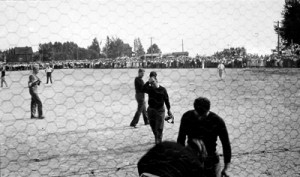 Games which featured Old Timers were also crowd pleasers. As expected, large crowds turned up to watch Old Time baseballers including “Boxcar McDonald”, “Gutty” Lockhart, and “Cap” Weegar in a challenge game against the CPR Ceepees. A photo (left) of a baseball game in 1935 suggests that large crowds watched some of the games.
Games which featured Old Timers were also crowd pleasers. As expected, large crowds turned up to watch Old Time baseballers including “Boxcar McDonald”, “Gutty” Lockhart, and “Cap” Weegar in a challenge game against the CPR Ceepees. A photo (left) of a baseball game in 1935 suggests that large crowds watched some of the games.
